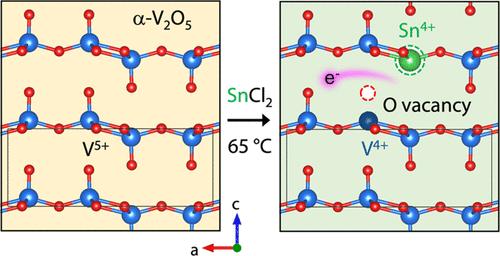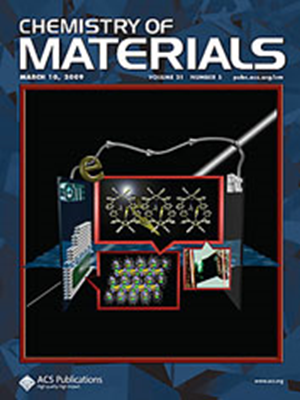Tuning Optical and Electrical Properties of Vanadium Oxide with Topochemical Reduction and Substitutional Tin
IF 7.2
2区 材料科学
Q2 CHEMISTRY, PHYSICAL
引用次数: 0
Abstract
Vanadium oxides are widely tunable materials, with many thermodynamically stable phases suitable for applications spanning catalysis to neuromorphic computing. The stability of vanadium in a range of oxidation states enables mixed-valence polymorphs of kinetically accessible metastable materials. Low-temperature synthetic routes to, and the properties of, these metastable materials are poorly understood and may unlock new optoelectronic and magnetic functionalities for expanded applications. In this work, we demonstrate topochemical reduction of α-V2O5 to produce metastable vanadium oxide phases with tunable oxygen vacancies (>6%) and simultaneous substitutional tin incorporation (>3.5%). The chemistry is carried out at low temperature (65 °C) with solution-phase SnCl2, where Sn2+ is oxidized to Sn4+ as V5+ sites are reduced to V4+ during oxygen vacancy formation. Despite high oxygen vacancy and tin concentrations, the transformations are topochemical in that the symmetry of the parent crystal remains intact, although the unit cell expands. Band structure calculations show that these vacancies contribute electrons to the lattice, whereas substitutional tin contributes holes, yielding a compensation doping effect and control over the electronic properties. The SnCl2 redox chemistry is effective on both solution-processed V2O5 nanoparticle inks and mesoporous films cast from untreated inks, enabling versatile routes toward functional films with tunable optical and electronic properties. The electrical conductance rises concomitantly with the SnCl2 concentration and treatment time, indicating a net increase in density of free electrons in the host lattice. This work provides a valuable demonstration of kinetic tailoring of electronic properties of vanadium–oxygen systems through top-down chemical manipulation from known thermodynamic phases.

用拓扑化学还原和取代锡调谐氧化钒的光学和电学特性
钒氧化物是一种具有广泛可调性的材料,具有许多热力学稳定相,适用于从催化到神经形态计算的各种应用。钒在一系列氧化态中的稳定性使得混合价态多晶体成为动力学上可获得的可转移材料。人们对这些可蜕变材料的低温合成路线及其特性知之甚少,而这些材料可能会释放出新的光电和磁性功能,从而扩大其应用范围。在这项工作中,我们展示了对 α-V2O5 的拓扑化学还原,以产生具有可调氧空位(6%)和同时取代性锡掺杂(3.5%)的可蜕变氧化钒相。化学反应是在低温(65 °C)下用溶液相 SnCl2 进行的,在氧空位形成过程中,当 V5+ 位点被还原为 V4+ 时,Sn2+ 被氧化为 Sn4+。尽管氧空位和锡的浓度很高,但这种转化具有拓扑化学性质,即母体晶体的对称性保持不变,只是单位晶胞扩大了。带状结构计算表明,这些空位为晶格提供了电子,而取代锡则提供了空穴,从而产生了补偿掺杂效应并控制了电子特性。SnCl2 氧化还原化学对溶液处理的 V2O5 纳米粒子墨水和由未经处理的墨水浇铸而成的介孔薄膜均有效,从而实现了具有可调光学和电子特性的功能薄膜的多功能途径。电导率随 SnCl2 浓度和处理时间的增加而上升,表明宿主晶格中自由电子密度的净增加。这项工作通过自上而下的化学操作,从已知的热力学阶段出发,对钒氧系统的电子特性进行了动力学定制,提供了宝贵的示范。
本文章由计算机程序翻译,如有差异,请以英文原文为准。
求助全文
约1分钟内获得全文
求助全文
来源期刊

Chemistry of Materials
工程技术-材料科学:综合
CiteScore
14.10
自引率
5.80%
发文量
929
审稿时长
1.5 months
期刊介绍:
The journal Chemistry of Materials focuses on publishing original research at the intersection of materials science and chemistry. The studies published in the journal involve chemistry as a prominent component and explore topics such as the design, synthesis, characterization, processing, understanding, and application of functional or potentially functional materials. The journal covers various areas of interest, including inorganic and organic solid-state chemistry, nanomaterials, biomaterials, thin films and polymers, and composite/hybrid materials. The journal particularly seeks papers that highlight the creation or development of innovative materials with novel optical, electrical, magnetic, catalytic, or mechanical properties. It is essential that manuscripts on these topics have a primary focus on the chemistry of materials and represent a significant advancement compared to prior research. Before external reviews are sought, submitted manuscripts undergo a review process by a minimum of two editors to ensure their appropriateness for the journal and the presence of sufficient evidence of a significant advance that will be of broad interest to the materials chemistry community.
 求助内容:
求助内容: 应助结果提醒方式:
应助结果提醒方式:


